Citroen JUMPY MULTISPACE DAG 2008.5 2.G Owner's Manual
Manufacturer: CITROEN, Model Year: 2008.5, Model line: JUMPY MULTISPACE DAG, Model: Citroen JUMPY MULTISPACE DAG 2008.5 2.GPages: 194, PDF Size: 6.92 MB
Page 151 of 194

149
Child safety
SAFETY
5
CHILD SEATS RECOMMENDED BY CITROËN
CITROËN offers a complete range of recommended child seats which are secured using a three point seat belt :
Group 0: from birth to 10 kg
Group 0+: from birth to 13 kg
L1
"ROMER Baby-Safe Plus"
Installed in the rear-facing position
Groups 1, 2 and 3: from 9 to 36 kg
L2
"KIDDY Life"
For the safety of young children (from 9 to 18 kg),
CITROËN recommends use of the restraining cushion .
Groups 2 and 3: from 15 to 36 kg
L3
"RECARO Start''
L4
"KLIPPAN Optima"
From the age of 6 years (approximately 22 kg),
the booster is used on its own.
Page 152 of 194

150
Child safety
Row 2 Side seats
U U U U
Centre seat U U U U
Row 3 Side seats
U U U U
Centre seat U U U U
a: Group 0: from birth to 10 kg.
b: consult the legislation in force in your country b efore installing your child on this seat.
U: seat suitable for the installation of a child seat secured using a seat belt and universally approved , "rear facing" and/or "forward facing".
INSTALLING CHILD SEATS ATTACHED USING THE SEAT BEL T
This table indicates the options for installing child seats secured using a seat belt and universally approved in accordance with the weight of
the child and the seat in the vehicle.
Seat
Weight of the child and indicative age
Under 13 kg
(groups 0 (a)
and 0+)
Up to
�≈ 1 year
From 9 to 18 kg
(group 1)
1 to �≈ 3 years
From 15 to 25 kg
(group 2)
3 to �≈ 6 years
From 22 to 36 kg
(group 3)
6 to �≈ 10 years
Row 1 (b) Individual seat
U U U U
Bench, side seat
U U U U
Bench, centre seat
L1 L2 L2, L3, L4 L2, L3, L4
Page 153 of 194

151
Child safety
SAFETY
5
Disarm the passenger air bag when a "rear
facing" child seat is installed on the front
seat.
Otherwise, the child would risk being
seriously injured or killed if the air bag were
to inflate. To protect young children from the rays of
the sun, fit side blinds to the rear windows. ADVICE ON CHILD SEATS
The incorrect installation of a child seat in a
vehicle compromises the child's protection in
the event of an accident.
Remember to fasten the seat belts or the
child seat harnesses
keeping the slack in
relation to the child's body to a minimum ,
even for short journeys.
For optimum installation of the "forward
facing" child seat, ensure that the back of
the child seat is in contact with the back of
the vehicle's seat and that the head restraint
does not cause any discomfort.
If the head restraint has to be removed,
ensure that it is stored or attached securely
to prevent it from being thrown around the
vehicle in the event of sharp braking.
Children under the age of 10 must not travel
in the "forward facing" position on the front
passenger seat, unless the rear seats are
already occupied by other children, cannot
be used or are absent.
Installing a booster seat
The chest part of the seat belt must be
positioned on the child's shoulder without
touching the neck.
Ensure that the lap part of the seat belt
passes correctly over the child's thighs.
CITROËN recommends the use of a booster
seat which has a back, fitted with a seat belt
guide at shoulder level.
As a safety precaution, do not leave:
- one or more children alone and unsupervised in a vehicle,
- a child or an animal in a vehicle which is exposed to the sun, with the windows
closed,
- the keys within reach of children inside the vehicle.
To prevent accidental opening of the doors,
use the "Child Lock".
Take care not to open the rear windows by
more than one third.
Page 154 of 194
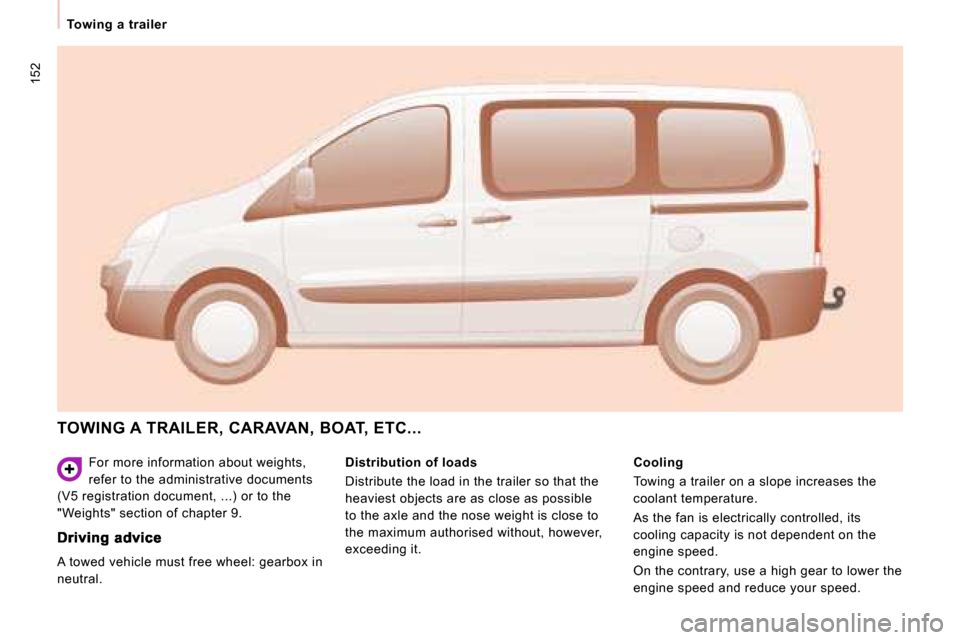
152
Towing a trailer
For more information about weights,
refer to the administrative documents
(V5 registration document, ...) or to the
"Weights" section of chapter 9.
TOWING A TRAILER, CARAVAN, BOAT, ETC...
Distribution of loads
Distribute the load in the trailer so that the
heaviest objects are as close as possible
to the axle and the nose weight is close to
the maximum authorised without, however,
exceeding it.
Cooling
Towing a trailer on a slope increases the
coolant temperature.
As the fan is electrically controlled, its
cooling capacity is not dependent on the
engine speed.
On the contrary, use a high gear to lower the
engine speed and reduce your speed.
A towed vehicle must free wheel: gearbox in
neutral.
Page 155 of 194
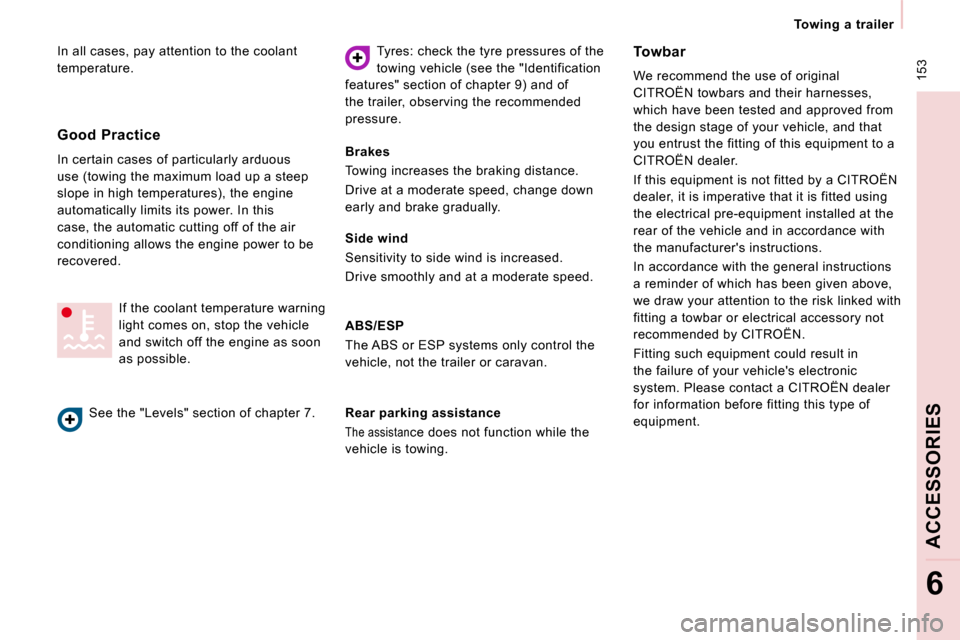
153
Towing a trailer
ACCESSORIES
6
In all cases, pay attention to the coolant
temperature. Tyres: check the tyre pressures of the
towing vehicle (see the "Identification
features" section of chapter 9) and of
the trailer, observing the recommended
pressure. Towbar
We recommend the use of original
CITROËN towbars and their harnesses,
which have been tested and approved from
the design stage of your vehicle, and that
you entrust the fitting of this equipment to a
CITROËN dealer.
If this equipment is not fitted by a CITROËN
dealer, it is imperative that it is fitted using
the electrical pre-equipment installed at the
rear of the vehicle and in accordance with
the manufacturer's instructions.
In accordance with the general instructions
a reminder of which has been given above,
we draw your attention to the risk linked with
fitting a towbar or electrical accessory not
recommended by CITROËN .
Fitting such equipment could result in
the failure of your vehicle's electronic
system. Please contact a CITROËN dealer
for information before fitting this type of
equipment.
If the coolant temperature warning
light comes on, stop the vehicle
and switch off the engine as soon
as possible.
Good Practice
In certain cases of particularly arduous
use (towing the maximum load up a steep
slope in high temperatures), the engine
automatically limits its power. In this
case, the automatic cutting off of the air
conditioning allows the engine power to be
recovered.
See the "Levels" section of chapter 7.
Brakes
Towing increases the braking distance.
Drive at a moderate speed, change down
early and brake gradually.
Side wind
Sensitivity to side wind is increased.
Drive smoothly and at a moderate speed.
ABS/ESP
The ABS or ESP systems only control the
vehicle, not the trailer or caravan.
Rear parking assistance
The assistance does not function while the
vehicle is towing.
Page 156 of 194
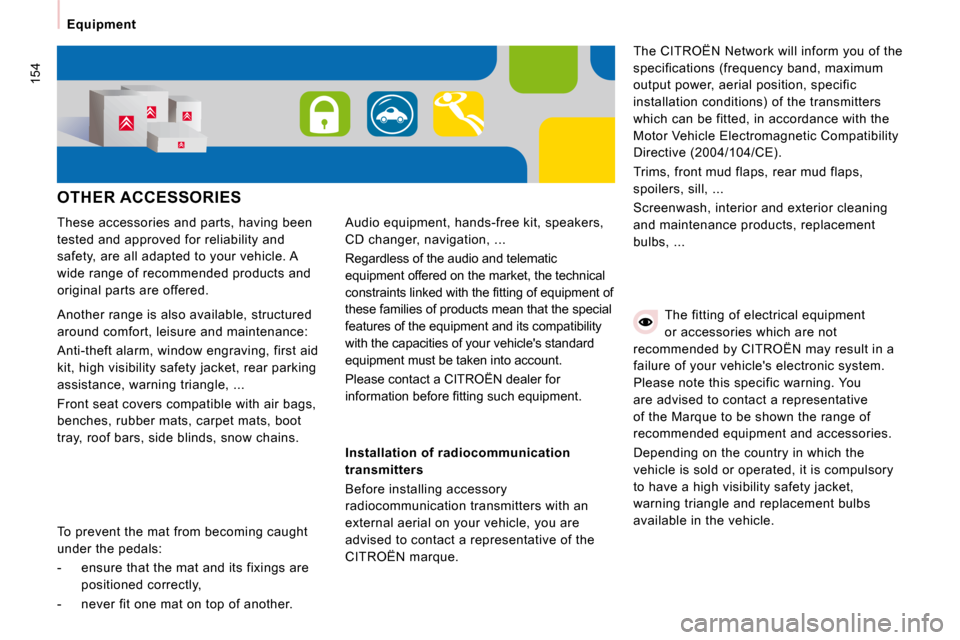
154
Equipment
OTHER ACCESSORIES
These accessories and parts, having been
tested and approved for reliability and
safety, are all adapted to your vehicle. A
wide range of recommended products and
original parts are offered.
Another range is also available, structured
around comfort, leisure and maintenance:
Anti-theft alarm, window engraving, first aid
kit, high visibility safety jacket, rear parking
assistance, warning triangle, ...
Front seat covers compatible with air bags,
benches, rubber mats, carpet mats, boot
tray, roof bars, side blinds, snow chains. The CITROËN Network will inform you of the
specifications (frequency band, maximum
output power, aerial position, specific
installation conditions) of the transmitters
which can be fitted, in accordance with the
Motor Vehicle Electromagnetic Compatibility
Directive (2004/104/CE).
Trims, front mud flaps, rear mud flaps,
spoilers, sill, ...
Screenwash, interior and exterior cleaning
and maintenance products, replacement
bulbs, ...
Installation of radiocommunication
transmitters
Before installing accessory
radiocommunication transmitters with an
external aerial on your vehicle, you are
advised to contact a representative of the
CITROËN marque.
To prevent the mat from becoming caught
under the pedals:
- ensure that the mat and its fixings are
positioned correctly,
- never fit one mat on top of another. Audio equipment, hands-free kit, speakers,
CD changer, navigation, ...
Regardless of the audio and telematic
equipment offered on the market, the technical
�c�o�n�s�t�r�a�i�n�t�s� �l�i�n�k�e�d� �w�i�t�h� �t�h�e� �fi� �t�t�i�n�g� �o�f� �e�q�u�i�p�m�e�n�t� �o�f
�
these families of products mean that the special
features of the equipment and its compatibility
with the capacities of your vehicle's standard
equipment must be taken into account.
Please contact a CITROËN dealer for
�i�n�f�o�r�m�a�t�i�o�n� �b�e�f�o�r�e� �fi� �t�t�i�n�g� �s�u�c�h� �e�q�u�i�p�m�e�n�t�.� The fitting of electrical equipment
or accessories which are not
recommended by CITROËN may result in a
failure of your vehicle's electronic system.
Please note this specific warning. You
are advised to contact a representative
of the Marque to be shown the range of
recommended equipment and accessories.
Depending on the country in which the
vehicle is sold or operated, it is compulsory
to have a high visibility safety jacket,
warning triangle and replacement bulbs
available in the vehicle.
Page 157 of 194

155
Opening the bonnet
CHECKS
7
OPENING THE BONNET
From inside:
- lift the cover located at the left foot of the driver's seat.
- pull the control upwards. To close
Lower the bonnet and release it at the end of its
travel. Check that the bonnet is properly locked.
From outside: partially open the bonnet, lift
the catch and raise the bonnet.
Bonnet strut
Secure the strut in one of the two notches,
according to the height required, to hold the
bonnet open.
Before closing the bonnet, replace the strut
in its housing. "Bonnet open" warning
This warning is linked to the
alarm
option only.
With the engine running or the
vehicle moving, a warning light
and a diagram on the display,
accompanied by an audible
signal, warn you that the bonnet is not
properly closed.
Page 158 of 194
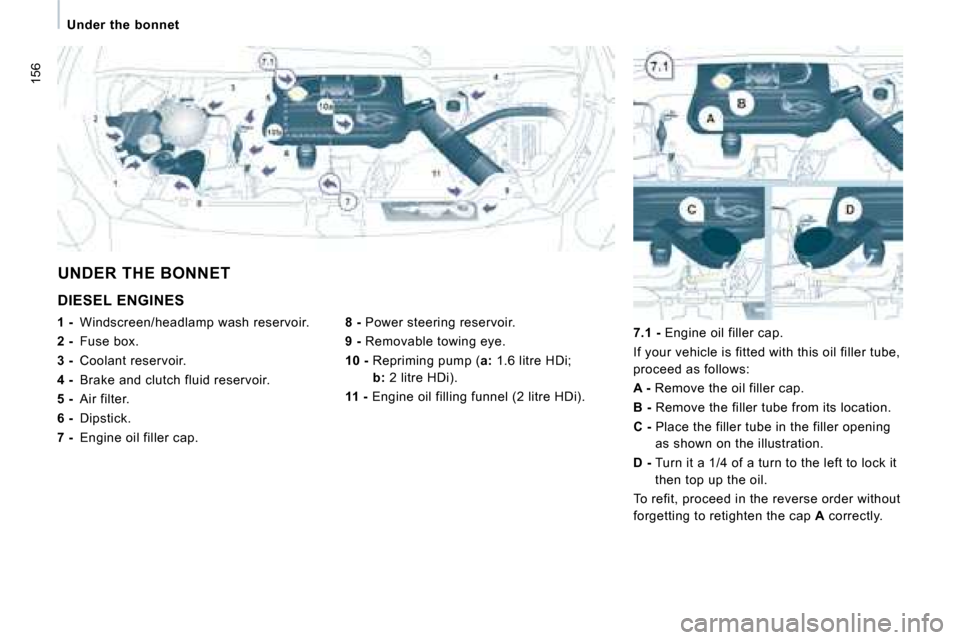
156
Under the bonnet
DIESEL ENGINES
8 - Power steering reservoir.
9 - Removable towing eye.
10 - Repriming pump ( a: 1.6 litre HDi;
b: 2 litre HDi).
11 - Engine oil filling funnel (2 litre HDi).
UNDER THE BONNET
1 - Windscreen/headlamp wash reservoir.
2 - Fuse box.
3 - Coolant reservoir.
4 - Brake and clutch fluid reservoir.
5 - Air filter.
6 - Dipstick.
7 - Engine oil filler cap.
7.1 - Engine oil filler cap.
If your vehicle is fitted with this oil filler tub e,
proceed as follows:
A - Remove the oil filler cap.
B - Remove the filler tube from its location.
C - Place the filler tube in the filler opening
as shown on the illustration.
D - Turn it a 1/4 of a turn to the left to lock it
then top up the oil.
To refit, proceed in the reverse order without
forgetting to retighten the cap A correctly.
Page 159 of 194
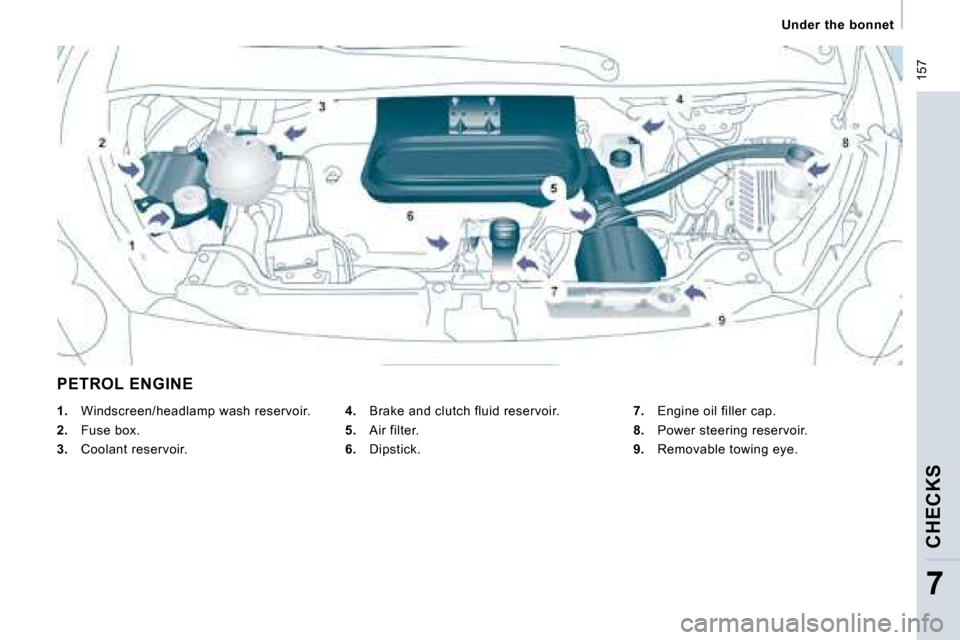
157
Under the bonnet
CHECKS
7
PETROL ENGINE
4. Brake and clutch fluid reservoir.
5. Air filter.
6. Dipstick.
1. Windscreen/headlamp wash reservoir.
2. Fuse box.
3. Coolant reservoir.
7. Engine oil filler cap.
8. Power steering reservoir.
9. Removable towing eye.
Page 160 of 194
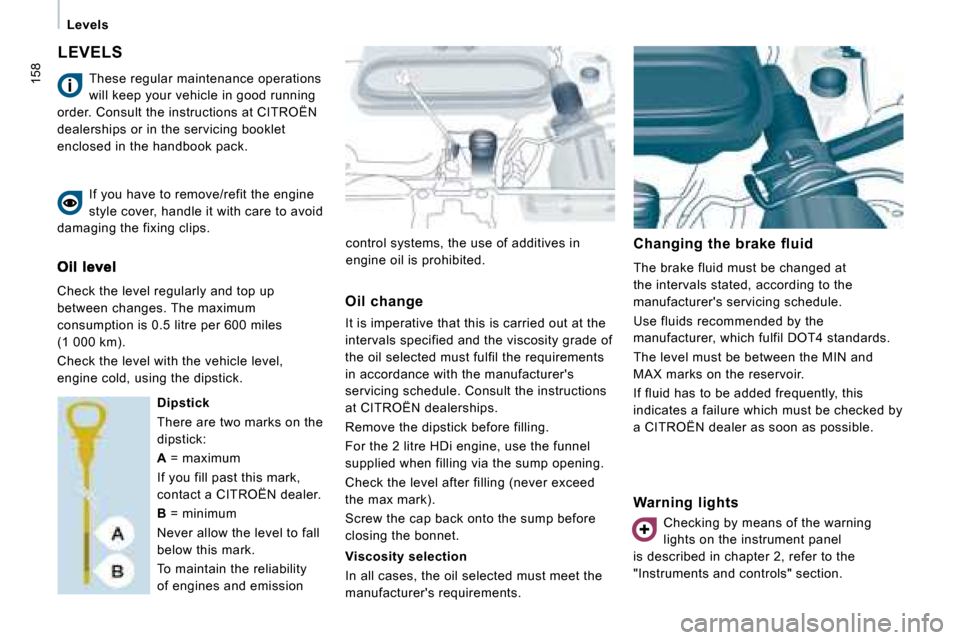
158
Levels
LEVELS
control systems, the use of additives in
engine oil is prohibited. Changing the brake fluid
The brake fluid must be changed at
the intervals stated, according to the
manufacturer's servicing schedule.
Use fluids recommended by the
manufacturer, which fulfil DOT4 standards.
The level must be between the MIN and
MAX marks on the reservoir.
If fluid has to be added frequently, this
indicates a failure which must be checked by
a CITROËN dealer as soon as possible.
These regular maintenance operations
will keep your vehicle in good running
order. Consult the instructions at CITROËN
dealerships or in the servicing booklet
enclosed in the handbook pack.
If you have to remove/refit the engine
style cover, handle it with care to avoid
damaging the fixing clips.
Check the level regularly and top up
between changes. The maximum
consumption is 0.5 litre per 600 miles
(1 000 km).
Check the level with the vehicle level,
engine cold, using the dipstick.
Dipstick
There are two marks on the
dipstick:
A = maximum
If you fill past this mark,
contact a CITROËN dealer.
B = minimum
Never allow the level to fall
below this mark.
To maintain the reliability
of engines and emission Oil change
It is imperative that this is carried out at the
intervals specified and the viscosity grade of
the oil selected must fulfil the requirements
in accordance with the manufacturer's
servicing schedule. Consult the instructions
at CITROËN dealerships.
Remove the dipstick before filling.
For the 2 litre HDi engine, use the funnel
supplied when filling via the sump opening.
Check the level after filling (never exceed
the max mark).
Screw the cap back onto the sump before
closing the bonnet.
Viscosity selection
In all cases, the oil selected must meet the
manufacturer's requirements.
Warning lights
Checking by means of the warning
lights on the instrument panel
is described in chapter 2, refer to the
"Instruments and controls" section.